
Places to Visit
Ahmedabad is located in the state of Gujarat in the western part of India on the banks of Sabarmati River. The city offers a unique style of architecture which is a blend of Hindu and Islamic styles. It is famous for its textile mills, pharmaceuticals, and chemical industry. It has places of tourist attraction like Gandhi Ashram, Akshardham, Calico museum, Nal Sarovar (bird sanctuary) and monuments which date back to the 15th century.
Gandhi Ashram
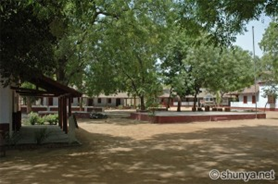 |
For many years Ahmedabad was the centre of Mahatma Gandhi’s non-violent struggle for India’s independence. The energy of that movement can still be felt at the Satyagraha Ashram that he established on the banks of the Sabarmati in 1917, after the previous Kochrab Ashram had to be abandoned because of a breakout of plague. He chose a location that was, at the time, far out of the city so that he could try farming and other such experiments. He learnt the art of spinning and weaving, and soon the ashram began to buzz with khadi, not just as a way of producing clothes, but also as a way of thought. The activity waned when he moved to Sevagram Ashram near Wardha, Maharashtra, after the Namak Satyagraha, leaving the Ashram in the hands of the Harijan Sevak Sangh. |
You can get a sense of his life, the history of the movement and those who worked alongside him, at the Gandhi Smarak Sangrahalaya, a small museum that includes excellent pictorial and written documentation, a library of Gandhian literature and paintings, and an immense archive of letters written by Gandhiji, every single one on the back of used paper. The grounds include the Hridaykunj, Gandhiji's sparse living quarters, Vinoba-Mira Kutir, where Vinoba and Mira each stayed on separate visits, a prarthana bhumi, a guest house and a building used as a training center for cottage industries, all preserved as part of the museum. The grounds are open from sunrise to sunset, but the best time to visit these grounds is early morning, as the sun rises over the river, and people are in a meditative spirit. Tucked away on one side is also Manav Sadhna, a non-profit Gandhian organization dedicated to seva. Many of the people who work or volunteer in the group live in the ashram, which actually covers a lot more than just the preserved memorial grounds. Across the road is a whole residential neighborhood of families, many of which have elders who worked alongside Gandhiji, and have the history of the movement built into their houses, inevitably reaching the younger generations. Near the memorial grounds in the rest of the Ashram is the Environmental Sanitation Institute, an organization that addresses waste-related diseases and ecologically minded sanitation, Kalam Kush, where beautiful hand-made paper is made, as well as spinning wheels and other equipment, three khadi stores, and most recently, a khadi weaving workshop to re-educate people about the concept, resuscitating the activity after decades of lull following Gandhiji’s move to the Sevagram Ashram. After the move, it may have seemed that the ashram was no longer functioning, but generations later, the people who populate Manav Sadhna, or work in the ashram bookstore, or the fact that the new khadi workshop is run by the grandson of the couple who taught Gandhiji and his cohorts to make khadi, are all testament to the living legacy left behind. |
|
Dada Harir Vav (Stepwell)
In the quiet neighbourhood of Asarwa village, northeast of the walled, tucked away between a sleepy residential area and the coal yards of Ahmedabad on a little side street, you will find Dada Harir Vav. At ground level you may not see much, but as you step up to the top of the stairs, you suddenly see a deep cascade of stairs and columns plunging down several stories, with shafts of light falling on beautiful carvings and birds and bats flitting in and out of the shadowy corners. |
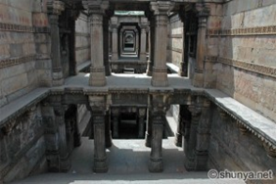 |
Built around 500 years ago by Sultan Bai Harir, this step well is like others around Gujarat, with elaborate craftsmanship and construction built underground to provide access to a permanent source of water. For many years, step wells like this one provided most of the water for the city during the long dry seasons. On the walls as you descend, you will find carvings of all type, including some in Sanskrit as well as in Arabic script. |
|
The well is best visited in the late morning when light penetrates down the shaft. To reach the site, it is best to find an auto rickshaw driver who knows the place to take you there. Buses come nearby, but then it can be quite roundabout to find it on foot. |
|
Sarkhej Roza
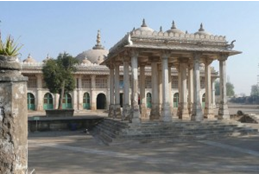 |
About 8 kms. from the city, Sarkhej comprises one of the most elegant architectural complexes of Ahmedabad. Grouped around a great stepped tank is the tomb to the saint, Ahmed Khattu Ganj Baksh (1445), the mosque, the tombs of Mehmud Shah Begada and his queen, and the palace and pavilions. The buildings are remarkable for the complete absence of arches and the use of pierced stone trellises throughout. |
Akshardham
Akshardham is majestic, intricately carved stone structure which stands amid sprawling gardens set in a 23-acre plot at Gandhinagar (Gandhinagar district). It is built in 6000 tonnes of pink sandstone and not a bit of steel has been used. The temple is 108 ft in height, 240 ft in length and 131 ft in width. A point worth noting is that this modern monument to Hinduism was built as per the injunctions of Vastu Shastra. The monument enshrining the seven foot high, gold-leafed Murti (idol) of Lord Swaminarayan is the focal point of the complex. |
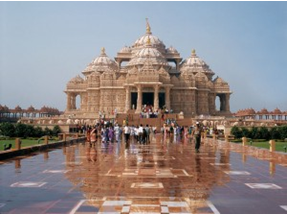 |
The monument stands on 7 sculpted pillars, 210 single-piece stone beams, 57 window grills, M domes, eight ornate zarokhas, etc. The sanctum sanctorum contains the 1.2 tonne gold-plated idol of Lord Swaminarayan, the founder of the sect that bears his name, shown in a sitting posture with his right hand raised in abhay mudra. He is flanked by Swami Gunatitanand on his right and Swami Gopalanand Swami on his left. Both of them were his disciples. Swami Gunatitanand is called Swaminarayan’s Akshardham, the eternal abode. According to the Swaminarayan philosophy whenever Lord Swaminarayan incarnates on this planet he brings with him his Akshardham. |
|
Gunatitanand Swami is also called Aksharbrahma and ranks second in the hierarchy of the Bochasanvasi Akshar Purushottam Sanstha which built the Akshardham monument. Inspiring episodes and incidents from the glorious history of Sanatan Dharma are presented in sound and light form for the benefit of the visitors. The show takes the visitors through various facets of Hinduism. The wisdom of the Vedas, the epics, the Puranas is depicted on a crowded canvas by the exhibition. The visitor comes face to face with personages who have made this land what it is.
It is a perfect mix of modernity and ancient values. Apart from Lord Rama going in search of his kidnapped wife, the visitor can see Shravan- the dutiful son, the Pandavas losing the game of dice in the Hastinapur palace, etc. Besides, the visitors can also see Sabari’s long wait for Lord Rama and Draupadi’s humiliation in the Kauravasabha. |
|
Kankaria Lake
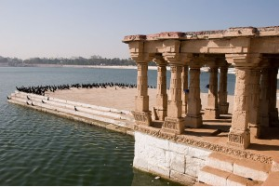 |
A polygonal lake almost a mile in circumference, it was constructed in 1451 by Sultan Qutb-ud-Din. In the centre of the lake is an island-garden with a summer palace known as Nagina Wadi. The lake is now a popular recreational centre and is surrounded by parks, ‘Bal Vatika’, children’s gardens, a boat club, natural history museum and a zoo. |
Sidi Sayeed Masjid
Off the eastern end of Nehru bridge stands the Sidi Sayeed mosque. Built in 1573, it is the last of the major mosques to be built in Ahmedabad under the Mughal rule. Surrounded by busy intersections, it presents a stark contrast to speeding buses and giant advertisements. |
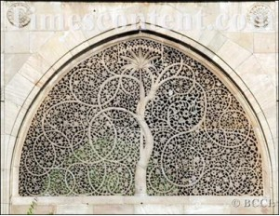 |
Hutheesing Jain Temple
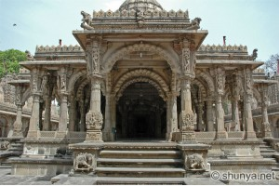 |
This remarkably elegant temple created out of white marble has been sacred to many Jain families, generation after generation. It was built in 1848 A.D. at an estimated cost of 10 lakh rupees by a rich merchant Sheth Hutheesing as a dedication to the 15th Jain tirthankar, Shri Dharmanatha. Traditional artisans working in stone belonged to the Sonpura & Salat communities. The Salat community constructed masterpieces of architecture ranging from forts, palaces to temples. The work of the Hutheesing Jain temple is attributed to Premchand Salat. One scholar has remarked, “Each part goes on increasing in dignity as we approach the sanctuary. Whether looked at from its courts or from the outside, it possesses variety without confusion and an appropriateness of every part to the purpose for which it was intended.” |
Located outside the Delhi Gate, the temple is spread over a sprawling courtyard, a mandapa surmounted by a large ridged dome, which is supported by 12 ornate pillars. The small garbhagruh (main shrine) on the east end reaches up into three stunningly carved spires and encircled by 52 small shrines dedicated to the various Tirthankars. There are large protruding porches with magnificently decorated columns and figural brackets on three outer sides. Also a recently built 78 ft Mahavir stambha (tower) fashioned after the renowned tower at Chittor in Rajasthan, flanks the outer courtyard by the front entrance. Some of the motifs used in the design remind one of the Sultanate minarets of the Mughal period. |
|
Science City
Located off the Sarkhej Gandhinagar Highway, Science City is an ambitious initiative of the government of Gujarat to trigger an inquiry of science in the mind of a common citizen with the aid of entertainment and experiential knowledge. Covering an area of more than 107 hectares, the idea is to create imaginative exhibits, virtual reality activity corners, and live demonstrations in an easily understandable manner. |
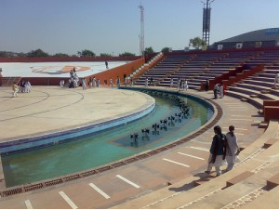 |
Hussain Doshi’s Gufa
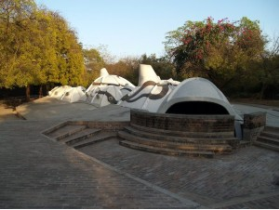 |
If you are looking for a quiet refuge in the midst of this bustling city, which is surrounded by trees, art and fantasy, than a visit to this underground cave gallery will do you good. Also popularly known as Amdavad ni Gufa on Kasturbhai Lalbhai campus. It is a creative union of two of India’s most imaginative minds, the celebrated architect B. V. Doshi and painter M F Hussain. |
Rani no Hajiro
On the street leading to the Queen’s (Rani no) tomb (hajiro), where the female members of the royal family were buried, is now a colorful market for ladies’ goods, crowded with women’s clothing and other items. It lies to the east of Manek Chowk.
Indroda Nature Park
Indroda Dinosaur and Fossil Park is a precious treasure spread over an area of about 400 hectares on either bank of Sabarmati river in Gandhinagar, the capital of Gujarat. It is considered to be the second largest hatchery of dinosaur eggs in the world. Regarded as India’s Jurrasic Park, it is run by the Gujarat Ecological Education and Research Foundation (GEER), and is the only dinosaur museum in the country. The park consists of a zoo, massive skeletons of sea mammals like the blue whale, as well as a vast botanical garden, amphitheatre, interpretation center and camping facilities. It also has a Wilderness Park which is home to innumerable species of birds, reptiles, hundreds of nilgais, langurs and peafowls in its vast forest. For more information, call 02712-21385; 20560.
CEPT Campus
School of Architecture was founded by B. V. Doshi in 1962 under The ‘Centre for Environmental Planning and Technology’ (CEPT). With the motto of ‘gnanam vignanamsahitam’, meaning ‘knowledge with science and spirituality’, today CEPT has grown into an autonomous university offering 3 under-graduate and 14 post-graduate programmes. School of Interior Design was founded by Ms. Krishna Shastri, a student of B.V. Doshi in 1991. At CEPT, efforts are made to instigate and improvise the sensitive and aesthetic dimensions of the students. Faculty and students together bring about a healthy and inspiring environment which results into volatile creativity . Students here, are exposed to a wide range of related studies starting from photography to music to crafts to religion to environment and culture, and are also encouraged to improvise and innovate in all the fields. The fully equipped workshop enables them to experiment and make things on their own. ‘Student exchange programs’ give them insights on global perspectives.
For further details please visit www.gujarattourism.com